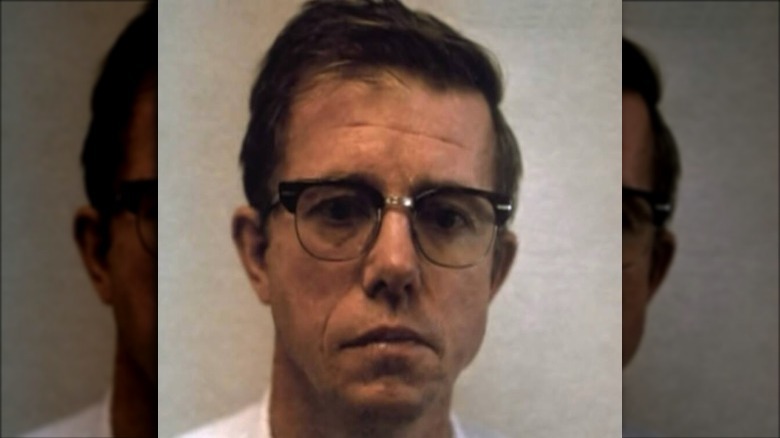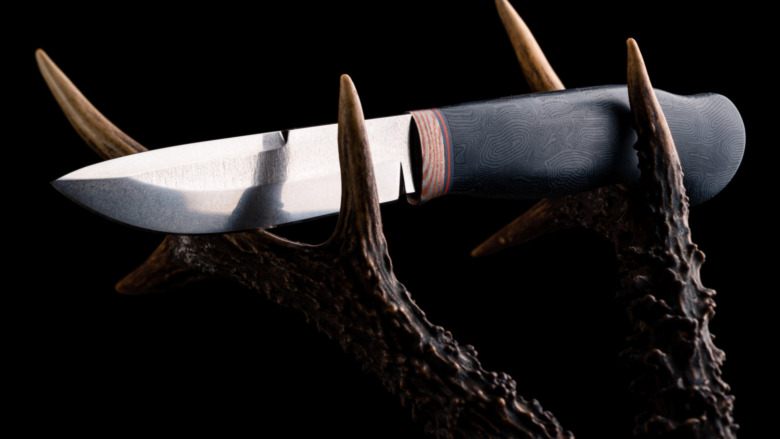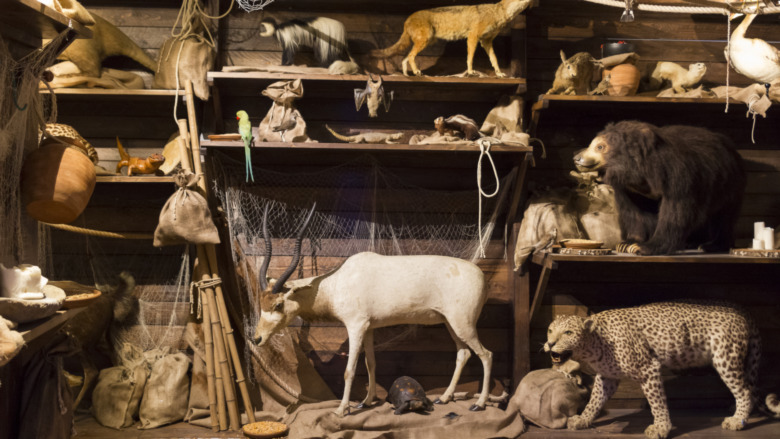How The Butcher Baker Was Eventually Caught
Robert Hansen, who earned the nickname "The Butcher Baker," could have been caught for good a decade before he was, saving at least 10 lives. The police and courts repeatedly neglected to take the threat seriously. Putting forward the façade of a kindly, upstanding baker, it was all too easy to look the other way on the accusations against him, even as the bodies of women kept being found in the Alaskan wilderness. According to New York Daily News, his assaults and murders occurred about every six months, beginning in the early 1970s. He was not caught until 1983 and only then because of a brave girl grabbing the attention of a detective ready to find an answer.
New York Times reported that Hansen lied to anyone in the legal system who might be fooled by his respectable businessman act, allowing him to escape notice even as his guilt became all but impossible to ignore.
Assistant District Attorney Frank Rothschild, speaking to a judge, said, "Before you sits a monster, an extreme aberration of a human being who has walked among us. Not even his wife of 20 years had any inkling of his dark, evil side. His crimes numb the mind."
The making of a monster
In 1939, Robert Hansen was born in Estherville, Iowa, to strict Danish immigrants, his father a baker. To his parents, he was a disappointment. He was naturally left-handed, but his parents saw that as deviance. They forced him to only use his right hand, underscoring to Hansen that he was born wrong. He credits having to use his non-dominant hand for developing a debilitating stutter.
Just as he started getting an interest in women, his face erupted in a horrible case of acne, one that scarred his face. New York Daily News quoted his confession to police — "I would see my friends and so forth going out on dates and so forth and had a tremendous desire to do the same thing. ... From the scars and so forth on my face you can probably see, I could see why girls wouldn't want to get close to me." ExploreNorth noted that even one of his victims said, "He sort of looked like the perfect dork."
He joined the Army Reserves in Kentucky to escape Estherville. But, in 1959, he returned to Iowa to work long hours in his father's bakery. He developed the misanthropy and misogyny that ruled his life and justified the crimes he would commit.
Escalating crimes
There did not seem to be a time in his life when Robert Hansen wasn't considering punishing the world. According to Robin Barefield, his position as owner of the bakery allowed him friends who would vouch for him and, at times, manufacture alibis.
Hansen had served stints in jail in the '60s and '70s. As Barefield notes, he was convicted of arson in 1960 and sentenced to three years, after setting fire to a bus barn. The psychologist at the prison labeled him as having an "infantile personality." He was precisely the sort of person who would re-offend and escalate further without severe rehabilitation.
His run-ins with the law didn't stop there. He loved to shoplift, and in November 1976, after stealing a chainsaw, Hansen was sentenced to five years in the Juneau Correctional Institute — though with the understanding that he would be eligible for parole quickly if he agreed to receive therapy. Hansen loved shoplifting to a perverse degree. According toHeavy, psychobiographers detailed that he was close to "ejaculating in his pants" whenever he stole something.
Hansen was released after 16 months, according to Robin Barefield.
Few consequences
Robert Hansen decided that he needed a fresh start. In 1967, he packed up and moved to Anchorage, Alaska.
In 1971, he was convicted of assault with a dangerous weapon for trying to assault 18-year-old Susie Heppeard, shoving a gun into her back, and saying, "Shut up, sweetheart, or I'll blow your head off."
After Heppeard, Hansen kidnapped Barbara Fields and assaulted her, says Heavy. She pleaded for her life, and he relented, though he wrote down her parents' address, saying he would kill them if she told anyone. (In dropping her off, he said he wished that they had met under better circumstances.) Days later, a college freshman's body was found in the ravine near where Hansen had assaulted Fields, so Fields came forward and identified him from a picture. He was arrested. Hansen's minister and friends said that he was harmless, and Fields must have been lying. Hansen's attorney maintained that Fields couldn't be trusted because she used drugs and was a dancer. Those charges were dropped.
Hansen was sentenced to five years for Heppeard. Dr. J. Ray Langdon, a court-appointed psychiatrist, noted that he suffered from a "dissociative mental illness," which Langdon theorized was the source of his criminal activities. He served six months. The New York Times reported that three of the four murders of which Hansen was found guilty occurred when he should have been still serving his sentence.
Alaska
Alaska in this era was a perfect place for a man like Robert Hansen. The 800-mile trans-Alaska oil pipeline was being built, attracting upwards of 28,000 men to work on the construction until it was finished in 1977. In short order, strip clubs sprung up with names like Booby Trap, the Gentleman's Retreat, and the Great Alaskan Bush Company, according to Last Podcast on the Left.
The women who worked in the strip clubs were not locals, mainly from the continental United States and drawn by the temptation of easy money. They would perform a circuit up the West Coast to Alaska and back again, never staying anywhere long enough for the patrons to get too attached. However, this transience also meant that, when a stripper or sex worker went missing, no one thought much of it. They may have just returned to the lower 48 to resume their jobs teaching or simply moved to a different club.
Robin Barefiled detailed how this boomtown money caused the population of Anchorage to expand beyond its borders. Since the Anchorage Police Department only focused its energy on the city proper, criminals figured out that the police would be bothered less by crimes outside the city limits.
And, of course, Alaska was remote. One could wander into the wilderness and not see anyone for days. It was perfect for what Hansen had planned.
"Good girls and bad girls"
As Robert Hansen saw it, there were only two kinds of women — good girls and bad girls. Good girls were to be protected and cherished. The New York Times quoted District Attorney Victor Krumm that Hansen considered bad girls "inferior, so it was all right" to murder them. They lost their humanity in his eyes, even though Hansen was hypocritically an avid patron of strip clubs and a client of sex workers. It wasn't his fault that he wanted them. It was their fault for letting him. New York Daily News reported that he said, "She had to come out and say we could do it but it's going to cost you some money. Then she was no longer I guess what you might call a decent girl."
According to Last Podcast on the Left, Hansen's first sexual experience was one that his army buddies bought him. Hansen was dejected that it wasn't "special," strictly an exchange of money for sex.
He was married twice. Shortly after their marriage, his first wife left him when he was arrested for conspiring with teenage employees at his parents' bakery to burn down a bus shed in Pocahontas, Iowa. The second woman, Darla Henrichsen, whom he married in 1963, was a devout Christian studying to be a teacher, according to Last Podcast on the Left. While he was destroying "bad girls" without qualms, he kept a "good girl" ignorant at home.
Escaping capture
Robert Hansen had barely unpacked his bags in Alaska before he started his crimes. In short order, the sex workers he had tried to assault spoke to the police, describing the stuttering, acne-scarred man. Hansen was too recognizable to have gotten away with it even once, but the police saw the choice before them. Who were they going to believe — Bob, the friendly neighborhood baker, or some sex worker?
Again and again, they chose Hansen. According to New York Daily News, the few times that the women pressed the issue, the police found reasons to ignore them.
There were no witnesses to the murders, since Alaska is so vast and empty. In a 1980 murder, according to ExploreNorth, Hansen went as far as to shoot a victim's dog so that the animal would not lead anyone to her grave.
The New York Times quoted Judge Ralph Moody of Superior Court — "I cannot think of a bigger indictment of society than we have here." Hansen was well-known to the courts — including twice on abduction and rape charges. Psychiatrists had pegged how dangerous he could be, women had reported him repeatedly, yet they "turned him loose several times."
Family man
The legal system was not his only ally. Robert Hansen got away with his crimes because he projected the image of a kindly family man who ran a bakery (one he bought using insurance fraud, according to ExploreNorth). For his disguise to work, he needed his wife and two children.
Darla Henrichsen swore that she had no idea that her husband was a serial killer, says Heavy. She might have been aware that he had patronized sex workers, but she was a good Christian and would not let his sin cause her to abandon her wedding vows.
Henrichson often spent the summers in Arkansas with the children, visiting family, while Hansen stayed behind. Additionally, according to The Cinemaholic, she kept the income she received from teaching learning disabled kids separate from Hansen's finances. Henrichsen supported him after he was arrested for trying to abduct Susie Heppeard and assaulting Barbara Fields. Heavy quoted Leland Hale, author of "Butcher Baker" — "[Darla] visited him in jail, kids in tow, though even Bob knew it was profoundly humiliating for her. Stayed with him though he was verbally abusive to her and the children."
She waited two years after his serial murder conviction to divorce him, so strongly did she believe in the institution of marriage. She was exhausted with her children being bullied about their father and left Alaska behind forever.
Modus Operandi
Robert Hansen would troll the Tenderloin district, a place ruled by organized crime and the sex trade. If the women in strip clubs did nothing more than take off their clothes, according to Last Podcast on the Left, they could still be "good girls." Whenever they would suggest they were open to sex work, he would offer far over the going rate to leave with him.
Once in his car, he would pull a gun and assault them. That wasn't negotiable to him. He told them that, if they complied with everything and told no one, he would release them when he was done (which might take days), according to The Washington Post. If they fought back or argued, he had to murder them.
He would sometimes pack them, chained, onto his Piper Cub airplane and fly them into the remote wilderness. There, he would release them. If they tried to escape, that was his invitation to hunt them, according to All That's Interesting. Hansen was an award-winning bow hunter and took pride in bagging trophies, after all.
(Last Podcast on the Left noted that Hansen contested the accusation of hunting his victims. Yes, he murdered them, but he didn't give them a head start. He killed them at once because they weren't obeying him — if you believe the word of a convicted serial murderer.)
Criminal profile
According to Last Podcast on the Left, in 1980, the police stumbled upon one of Robert Hansen's victims, a woman named Joanna Messina. Unfortunately, a black bear had found her first. When they tried to get the remaining evidence, the bear returned. Given a choice between shooting an endangered animal — of which there were few — or investigating the death of a sex worker — of which there were many — they backed away.
Messina was far from the first body the police had found, but her murder started the wheels turning. Still, Mindhunters noted, it was not until 1983 that the FBI's Investigating Support Unit got involved. The police contacted John Douglas with the idea that they had a serial killer. Douglas said, "First tell me about the crimes and let me tell you about the guy."
Douglas' profile bore eerie similarities to Hansen — he had a stutter and pockmarked face. He had a trophy room containing not only mounted animals but also objects he had taken from his victims. He may be married to a religious woman and was considered "hardworking," said Robin Barefield. The police were aware of Hansen and how precisely he met this description. However, they would need more evidence than criminal profiling to get a search warrant.
Cindy Paulson is kidnapped
The turning point came from a 17-year-old girl named Cindy Paulson in June 1983. Robert Hansen had several encounters with her — including one she missed because she overslept — before he offered her $200 to perform oral sex on him, marking her as a bad girl.
Soon after she began, he slapped cuffs on her, then chains. He leveled a gun at her and explained that he wouldn't kill her if she complied. She didn't believe him but wanted to prolong her life as much as she could. But Paulson wasn't passive. She said in an interview in Butcher Baker, "You see, when we was driving I observed everything. 'Cause this motherf***er wasn't getting away with it."
He brought her back to his cabin, where he assaulted her several times (which Paulson heart-breakingly referred to as having "made love on a bearskin rug" in an interview with Sgt. Glenn Flothe in Butcher Baker).
She didn't fight him, believing that he meant it when he said he would kill her if she tried. As he was indeed a monster, he decided the next day that he would bring her into the wilderness on his plane. She would not be returning from that trip, even though she had done everything he demanded.
Cindy Paulson escapes
Robert Hansen handcuffed Cindy Paulson and put her in the back of his plane. When he stepped outside a moment, she bolted, handcuffs still on, barefoot. Paulson ran until she hit the road and managed to convince a trucker that she was in danger — ably demonstrated by Hansen chasing her with a gun, as she described in Butcher Baker.
The driver wanted to bring her straight to the police but, according to Last Podcast on the Left, she begged to be driven to the Mush Inn so she could contact her pimp. Still, the driver called the police as soon as he could.
According to Robin Barefield, Anchorage police officer Gregg Baker arrived to find Paulson still cuffed and in a state of terror. She pointed out the plane, registered to Hansen. According to Butcher Baker, she described what Hansen looked like ("He's got like frog warts on his face. Buck teeth."), his car ("A metallic green Buick Century. With a cut in the back."), the inside of his home, and that she left her shoes behind as evidence.
The police went to Hansen. Everything about her story checked out perfectly. Hansen told them that she was just some (underage) sex worker trying to extort him, according to New York Daily News. Hansen also had one of his friends provide an alibi. The prosecutor considered whether a teen sex worker was more credible than pillars of the community. He dropped the charges before they could be filed.
The hammer falls
Though the police department was only too happy to let off the local baker again, something didn't sit right with Detective Glenn Flothe. According to Robin Barefield, Flothe had been assigned to the case of the Knik River murders — Robert Hansen's victims — and was convinced there was a serial killer on the loose in Anchorage. Flothe started looking into the other accusations against Hansen and then obtained his records from Iowa. When he consulted John Douglas' profile, it all came together perfectly. It was almost as though many women had been trying to tell the police for years.
Then, according to The Line-Up, Flothe heard about Cindy Paulson, who had suffered the same brutality that befell the women he had been investigating. She had not only managed to survive but did so with detailed testimony that directly tied to Hansen — even if the prosecutor wanted to ignore it.
Owing to Paulson's bravery and quick thinking and Flothe's actual police work, finally, they had enough to convince a judge to grant them a warrant.
Fatal trophies
Robert Hansen took pride in the animals he hunted. According to Last Podcast on the Left, the Pope and Young Club stated that he set numerous records for the bow and arrow. He kept his taxidermy in his home, including a record-breaking Dall sheep. But his pride in trophies did not stop with the animals.
According to Robin Barefield, the warrant allowed police access to Hansen's home and bakery. In addition to his weapons, including one that matched the shell casings left at the crime scenes along the Knik River, police found a cache of jewelry. Among these was a necklace belonging to one of his victims. As John Douglas predicted, Hansen kept items from each of his murders so that he could relive his domination of his victims.
Behind the headboard of Hansen's bed, police found a map marked with 24 X's. A few of them were where bodies had already been found. If this map was what they thought it might be, there were more bodies out there.
According to Last Podcast on the Left, the police confronted Hansen's alibis with this evidence, saying that, if they wanted to keep this lie going, they would be before a grand jury soon enough. His friends quickly recanted.
Trial and conviction
Once arrested, The Washington Post reported, Robert Hansen confessed to a steadily increasing number of murders and at least 30 assaults. He understood that police had all they needed to put him away for the rest of his life — Alaska does not have the death penalty.
Hansen was tried for the four murders with the most substantial evidence, receiving a 461-year sentence plus life with no possibility of parole. He was not tried for all 17 murders that he confessed to in order to, according to Heavy, "spare his wife, and two children, the embarrassment of protracted legal proceedings." His memory for where he buried the women was so perfect that he was often within feet of a grave he had not seen in years.
According to Alaska Dispatch, Hansen began his sentence in Pennsylvania, wanting to avoid being locked up with men whose girlfriends he may have killed, but was returned to Spring Creek prison in Alaska in 1988, where he remained until his death at 75. Frank Rothschild, the assistant district attorney on his case, told Anchorage Daily News, "He's one of those kind of guys that you kind of hope every breath he takes in his life, there's some pain associated with it ..."
A few positives of this case, according to Robin Barefield, are that it inspired Alaska State Troopers to create methods to deal with sexual assault victims, and they built a $56 million crime lab to process evidence — neither of which existed previously.
If you or anyone you know has been a victim of sexual assault, help is available. Visit the Rape, Abuse & Incest National Network website or contact RAINN's National Helpline at 1-800-656-HOPE (4673).














